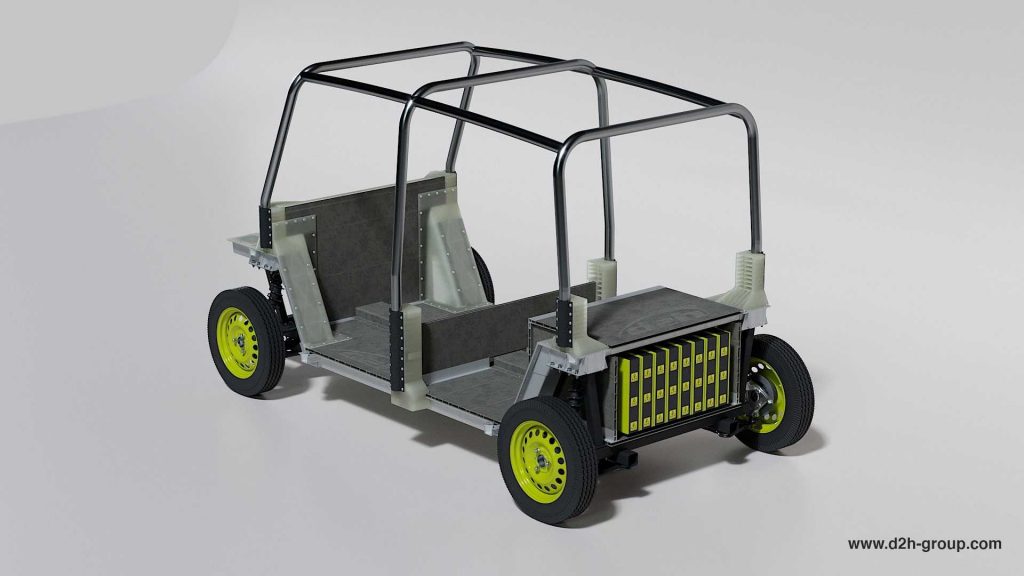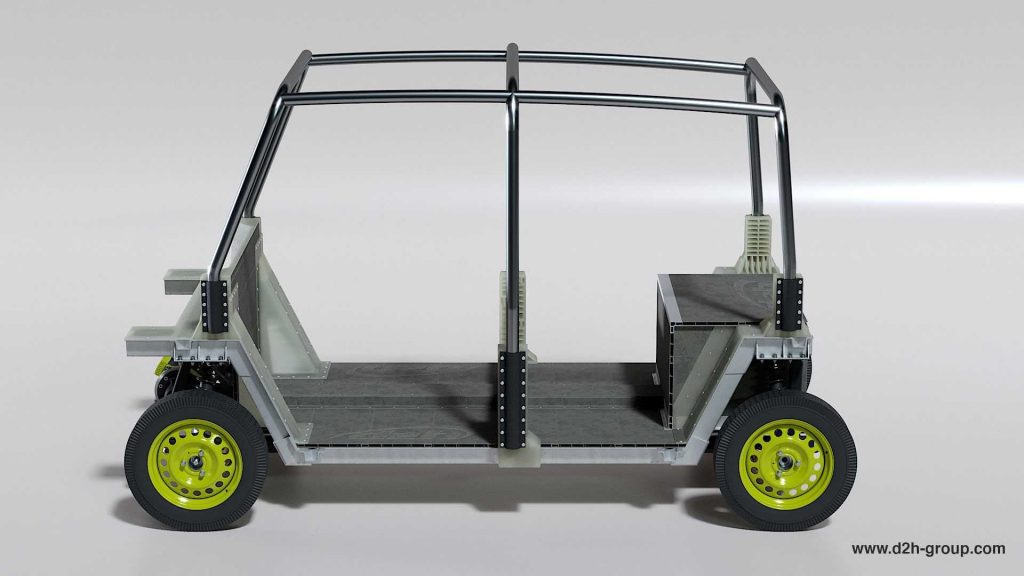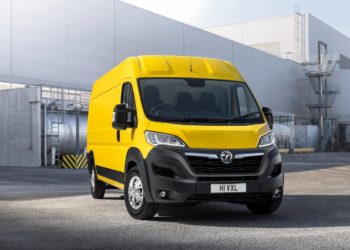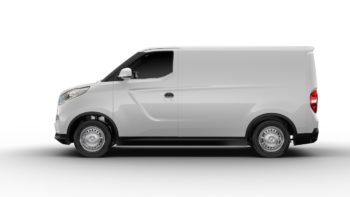In an effort to offer a safe, low cost and environment friendly alternative to the famous Tuk-Tuk or the ‘auto rickshaw’ as we know it in India, UK-based D2H engineering company has begun developing an electric quadricycle.
‘Tuk-Tuks’ (a name derived from the sound of the two-stroke engine) are famous in India and Asia but have been criticized for their poor safety standards and D2H wants to change that. While many companies are targeting high-performance concepts in their electric vehicle projects, D2H identified the need for a low cost, zero emission utility vehicle that can be adapted to different configurations. The company has developed the vehicle along with Coventive Composites and Warwick Manufacturing Group (WMG) as partners with funding assistance from Innovate UK.
The vehicle incorporates innovative materials and manufacturing processes that are simple and easily available in the target markets. It uses a jute-based natural fibre thermoplastic polymer, developed by Coventive Composites, that is lightweight and strong.
Matthew Hicks, D2H Engineering Director has said that when compared to metal alternatives, fibre reinforced thermoplastics have reduced energy requirements and manufacturing cycle times while allowing high levels of detail at the same time. The design prototype weighs 480 kg without the batteries and meets L7E Heavy Quadricycle EU classification. It uses proprietary suspension, brakes and steering from a current production chassis while the motor is mounted in the front and the battery packs stored in between the rear wheels.
D2H is looking to advance the design to prototype and testing stage and is keen to take in partners for further development. Hicks says that this vehicle is a modern, clean-running version of Tuk-Tuk and if they can create a lighter, zero-emission alternative that competes on cost and utility, then the company will have done the job.
Bajaj RE Electric & Qute Electric quadricycle in the pipeline
Bajaj Auto, the world’s biggest name in the three-wheeler business, has introduced the ‘Qute’ quadricycle (powered by a single-cylinder petrol engine) in parts of India and in many export markets, which by the virtue of its closed cabin and extra wheel, automatically makes it a safer form of public transport. The company began exports in 2015 (starting with Turkey) and one top Bajaj official has said that in due course, an electric version would be presented. The four-wheeler is marketed as a step-up to auto rickshaw owners.
As for the RE Electric (Bajaj electric auto rickshaw) on-road testing would have stalled due to the COVID-19 shutdown. The plan was to introduce the electric vehicle, powered by a 4.3 kW motor, around April this year, but we’re waiting for an update from the company on the revised plan.
Yet another innovation in the last-mile mobility segment is the Mahindra Atom electric quadricycle that was displayed at the 2020 Auto Expo featuring air-conditioning and connected tech.
D2H aiming to partner with a global OEM including Indian companies
ElectricVehicleweb.in caught up with engineering director Matthew Hicks on the progress of the quadricycle project. Hicks who says that India is a wonderfully industrious nation is amazed by the level of industry. Here’s what he told us last week:
Edited Excerpt
Can you share little about you, your company and how it came into being?
Matthew Hicks: I have predominantly worked in the high end of motorsport involving Formula One, Indy cars in America, the World Rally Championship and so on.
Prior to starting in D2H, I was working with a company that was doing some engineering consultancy work. I left the company and partnered with a former colleague, who was starting D2H. I joined to run the mechanical engineering and design side of the business.
D2H started in 2015. We are a design, engineering consultancy, we work in a variety of fields. As directors we have all come from a motorsport background, so we’ve obviously picked up some motorsports work. Beyond that, we’ve worked on different projects right from Olympic, High Performance Sports development programs with Team GB, through to electric vehicle development programs, like designing carbon fiber suitcases, all kinds of things in between.
Could you enlighten us on your quadricycle project?
Matthew Hicks: The idea emerged from various conversations we have within D2H. We were discussing how mobility as a service will grow around the world and how the concept of a small vehicle could be used in the mobility industry as a service.
But we first started talking about a much higher price point vehicle with a lot of other parts attached to it as a concept. But that concept didn’t quite set right for us.
We observed that a lot of the electric vehicles in Europe are at a higher price point and we thought, if you’re going to try and get electric vehicles used more widely, you’ve got to make them more accessible, or it will be a missed opportunity.
It developed from this idea, mobility as a service in the Asian market – that then turned into an idea – what about if we looked at doing what could we do to innovate producing an electric vehicle at a low price in a slightly different way. And that’s where the project came from.
And that led into approaching Innovate UK along with Warwick manufacturing group and Coventive composites to get some funding to do the initial development work.
So could you also share with us where the quadricycle project is currently in its development?
Matthew Hicks: We’ve rested into development for the time being, because we’re starting a number of discussions with people about partnering for the power train and the energy storage systems. Then we will explore how we can take the vehicle into the prototype phase.
So rather than carrying on in too much detail right now, we’re trying to put partners in place and see where, collectively, we want to take that forward, so that we can make the right decisions for the vehicle architecture.
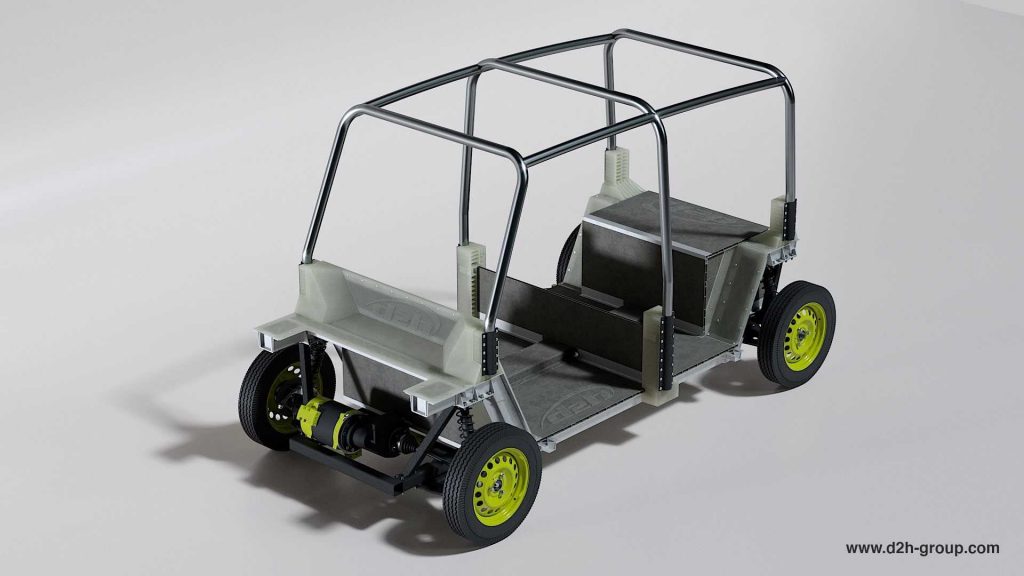
What will be the key features of your quadricycle?
Matthew Hicks: The original project and the funding we had from Innovate UK were to look at the development of the thermoplastic chassis on the vehicle. So we were very careful to concentrate our development around that area.
If you create an aesthetic design for the vehicle that steers people’s perceptions of what the vehicle is now and what it can potentially be. We wanted to start from a platform and say, here’s a platform that you could close in a way that suits a number of different applications.
Within the quadricycle market, we’re aiming at either the passenger side or the utility vehicle side, hence it’s been kept fairly light.
We’ve started to contemplate some form of body work partly to do with the discussions we’re having with potential partners because it helps them visualize things but we’re not at a point where we can release anything. The aim at the moment is to have a platform that can be easily adapted between the passenger and commercial vehicle variant. The commercial vehicle could have a box you have a refrigerated box on the back it could have a tipper variant it could be an open flat back. There are a number of different options possible due to its adaptability. So it will be simple in concept and design, but open to a lot more adaptability.
Can you tell us what is the provisioning that you’ve made in your frame? It appears similar to the Mahindra Atom which was showcased aAuto Expo 2020 which comes with high-end features for a quadricycle.
Matthew Hicks: Mahindra Atom is certainly a very interesting vehicle and it’s great to see that kind of development going on. In a good way, it is a direct competitor of the kind of vehicle that we’re potentially looking to produce here.
When we’ve designed the platform, it’s been designed around the L-7 category of vehicles, the heavy quadricycle. There is much more of a requirement for doors and for seat belts. Three wheeled vehicles in India are everywhere, and people are so used to them, and how they are and the access that you have in and out. They come with certain limitations on their safety and to add those safety features like doors and seatbelts changes how you use that vehicle.
If the desire within India and within the government is to improve road safety, one of the things people will have to start to think about more is that seat belts and wind screens and doors will become standard. it’s something we’re including.
Provisioning of air conditioning is yet to be resolved for our vehicle. The air conditioning is invariably linked to the cooling systems – that you need for the batteries. If one can bleed some of that to cool the cabin, then one can define the size of the air conditioning accordingly as you’ve got to accommodate both battery cooling and cabin cooling. And if your battery cooling is predominantly for when it’s on a charge, when it’s stationary, then use that air conditioning to cool the vehicle.
One of the reasons we chose the heavy quadricycle route was because there is an established set of worldwide regulations, I think.
We’re still trying to figure out some of the potential developments that are coming in India, because, you know, I think you have to be very much on the ground in India, and involved in the automotive industry there to know where things are being steered. It is a bit difficult to gauge from several thousand miles away. What the implications of some of the regulations and how India is going to implement regulations around the L-7 category is still a little unclear to us. There’s work going on there. We are in discussions with people within India about some of that.
On the safety regulations, there’s a real desire from within the Indian government to improve things and I think people in India start to earn a little bit more, their expectations on safety and what they want from their vehicles also improves.
Are you keen on partnering with an Indian company like Mahindra?
Matthew Hicks: We’re interested in finding partners, for powertrain, energy storage and the battery side of things, but we’re also very keen to talk with the vehicle manufacturers or OEMs in India, that might be interested in the project and being involved in the development and bringing their knowledge and expertise to that program. So we’re, we’re quite open minded about how we develop the project from this point forward.
Are you in discussion with any European OEM? What is a desirable framework for you to work on with OEs?
Matthew Hicks: I am not in position to discuss any of these things due to non-disclosure agreements. There are a number of meetings and discussions going on with a variety of companies, both within Europe and within India is probably the best way to describe it.
Discussions are quite varied. In some instances, we do an element of the development work to a point and then a partner may choose to develop it further for their particular market, right. There are other discussions that we’re having where it’s more a case of they become a partner in the business and it gets developed by us and they take the end vehicle.

